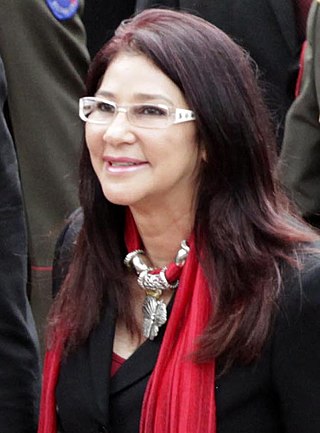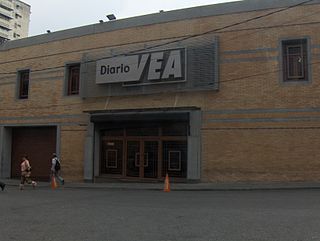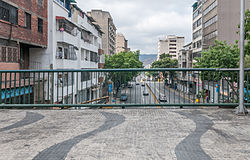Mass media in Venezuela comprise the mass and niche news and information communications infrastructure of Venezuela. Thus, the media of Venezuela consist of several different types of communications media: television, radio, newspapers, magazines, cinema, and Internet-based news outlets and websites. Venezuela also has a strong music industry and arts scene.
The Bolivarian Circles are political and social organizations of workers' councils in Venezuela, originally created by President Hugo Chávez on 21 December 2001. The circles have also been described as militias and compared to Cuba's Committees for the Defense of the Revolution and Panama's Dignity Battalions.

A failed coup d'état on 11 April 2002 saw the president of Venezuela, Hugo Chávez, ousted from office for 47 hours before being restored to power. Chávez was aided in his return to power by popular support and mobilization against the coup by loyal ranks in the military.
The assassination of Danilo Anderson took place on 18 November 2004, in Caracas, Venezuela. Danilo Baltasar Anderson was a Venezuelan environmental state prosecutor investigating more than 400 people accused of crimes during the Llaguno Overpass events and the failed 2002 coup d'état attempt. He was assassinated by a car bomb on his way home from attending postgraduate classes at aged 38. In 2005 several people were convicted of masterminding the assassination, though the investigation had flaws and was marred with allegations of corruption.

The Revolution Will Not Be Televised, also known as Chávez: Inside the Coup, is a 2003 Irish documentary film. It focuses on events in Venezuela leading up to and during the April 2002 coup d'état attempt, which saw President Hugo Chávez removed from office for two days. With particular emphasis on the role played by Venezuela's private media, the film examines several key incidents: the protest march and subsequent violence that provided the impetus for Chávez's ousting; the opposition's formation of an interim government headed by business leader Pedro Carmona; and the Carmona administration's collapse, which paved the way for Chávez's return. The Revolution Will Not Be Televised was directed by Irish filmmakers Kim Bartley and Donnacha Ó Briain. Given direct access to Chávez, the filmmakers intended to make a fly-on-the-wall biography of the president. They spent seven months filming in Venezuela, following Chávez and his staff and interviewing ordinary citizens. As the coup unfolded on 11 April, Bartley and Ó Briain filmed on the streets of the capital, Caracas, capturing footage of protesters and the erupting violence. Later, they filmed many of the political upheavals inside Miraflores, the presidential palace.

The Venezuelan coup attempt of February 1992 was an attempt to seize control of the government of Venezuela by the Hugo Chávez-led Revolutionary Bolivarian Movement-200 (MBR-200) that took place on 4 February 1992. The coup was directed against President Carlos Andrés Pérez and occurred in a period marked by economic liberalization reforms, which were attempted in order to decrease the country's level of indebtedness and had caused major protests and social unrest. Despite their failure to depose the government of Carlos Andrés, the February coup attempts brought Chávez into the national spotlight. Fighting during the coup resulted in the deaths of at least 143 people and possibly as many as several hundred.

Plan Ávila is a military contingency plan by the Venezuelan Army to maintain public order in the Venezuelan capital, Caracas. The plan was first implemented in 1989 by the Carlos Andrés Pérez government in response to the Caracazo riots, where hundreds were killed by military and armed police. President Hugo Chávez also ordered activation of the plan in response to the 11 April 2002 Llaguno Overpass events, but high-ranking members of the Armed Forces refused to carry out the plan, wanting to avoid a massacre like the Caracazo.
Lucas Rincón Romero is a Venezuelan military officer.

Cilia Adela Flores de Maduro is a Venezuelan lawyer and politician. She is married to the President of Venezuela Nicolás Maduro, making her the First Lady. Since 2015, she has also been a deputy in the National Assembly of Venezuela, of which she was president from 2006 to 2011, for her home state of Cojedes. In 2017, the Constituent National Assembly was founded, in which she is a member of the Presidential Commission.

Diario VEA is a daily newspaper in Venezuela. It was founded in Caracas in 2003. It is owned by the government. Its slogan is Comprometidos con Venezuela. Its director is Guillermo García Ponce. It comes in a tabloid format. It has been described as "the mouthpiece of the Bolivarian Revolution".

X-Ray of a Lie is a 2004 documentary film examining another film, The Revolution Will Not Be Televised, about the events of the Llaguno Overpass events, before the 2002 Venezuelan coup attempt. The X-Ray documentary, directed by Wolfgang Schalk and written by Schalk and Thaelman Urgelles, accuses Kim Bartley and Donacha O'Briain of omissions and distortion in The Revolution Will Not Be Televised. It premiered on DVD in Venezuela in July 2004.
Puente Llaguno: Claves de una Masacre (2004) is a documentary film about the events of the 2002 Llaguno Overpass events in Caracas, Venezuela.

Bolivarian propaganda is a form of nationalist propaganda, especially in Venezuela and associated with chavismo, Venezuelan socialism. This type of propaganda has been associated with Hugo Chávez's Bolivarian Revolution, which used emotional arguments to gain attention, exploit the fears of the population, create external enemies for scapegoat purposes, and produce nationalism within the population, causing feelings of betrayal for support of the opposition.

Miguel Eduardo Rodríguez Torres was the Minister of Interior, Justice and Peace of Venezuela from 2013, until he was replaced by Carmen Meléndez on 24 October 2014.

2018 protests in Venezuela began in the first days of January as a result of high levels of hunger by desperate Venezuelans. Within the first two weeks of the year, hundreds of protests and looting incidents occurred throughout the country. By late-February, protests against the Venezuelan presidential elections occurred after several opposition leaders were banned from participating. Into March, the Maduro government began to crack down on military dissent, arresting dozens of high-ranking officials including former SEBIN director Miguel Rodríguez Torres.

On 30 April 2019, during the Venezuelan presidential crisis, a group of several dozen military personnel and civilians joined Juan Guaidó in his call for the removal of Nicolás Maduro as part of what he labeled "Operation Freedom". Reuters reported an "uneasy peace" by the afternoon of 30 April. During the unrest, opposition leader Leopoldo López was freed from house arrest after being imprisoned for five years. Manuel Cristopher Figuera, the head of the Bolivarian Intelligence Service, denounced the Maduro government and was dismissed from his position before going into hiding. At least 25 military men who opposed Maduro sought asylum at the Brazilian embassy in Caracas.
The Venezuelan coup attempt of November 1992 was an attempt to seize control of the government of Venezuela that took place on 27 November 1992. It was led by a group of young military officers who were loyal to the Hugo Chávez-led Revolutionary Bolivarian Movement-200 (MBR-200), while Chávez was in prison for the February 1992 coup d'état attempt.

Coups d'état in Venezuela have occurred almost since the foundation of the Republic. Throughout the history of Venezuela, insurrections, uprisings, or military or civil revolutions were used to overthrow and replace governments. These coups were performed using force, intimidation, and pseudo-legal methods. Gradually with the consolidation of a democratic system in the country, coups became less and less common.

The Silence and the Scorpion is a book written by Brian A. Nelson and published in 2009 about the 2002 Venezuelan coup attempt.

A series of anti-government protests took place in Venezuela in the context of the 2004 recall referendum project, starting on 27 February 2004. Negotiations between the opposition and government agreeing on signatures led to the end of the protests. During the protests, 9 people were killed, of which at least 4 were due to the response of security officials, hundreds were injured and 300 were arrested.














